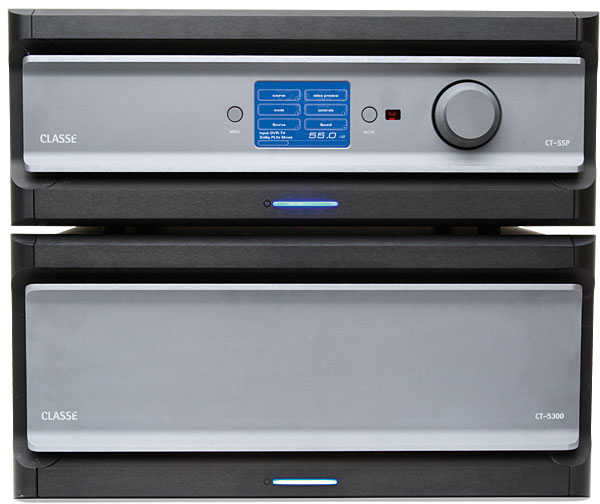How to Choose a Home Theater for Movies or Music Page 3
Schram’s receiver-as–surround processor plan has one little catch: You have to make sure the AVR has preamp output (or preout) jacks for all five of the primary theater channels. This lets you take the surround-decoded analog line-level signals off all five channels and feed them into something like the 5 x 250-watt Parasound Model 5250 v.2 ($2,850). Many $800-plus A/V receivers provide preout jacks, and something like this Parasound will likely offer a very significant power and sound-quality boost over what you’ll get from the AVR’s built-in amplifiers. Of course, you can also go with other, less expensive amplifier brands, some examples being Emotiva, Marantz, Outlaw, Rotel, etc. Although some new energy-efficient amplifier technologies are appearing these days, amplifiers will likely continue to function as they always have in the coming years. So investing in a great amp that will likely stick around through three or four generations of receiver upgrades over the next decade or two is a safe and sensible plan.

Going All the Way
Using a relatively inexpensive A/V receiver as your system’s processor and mating it with a gutsy amplifier will ensure superb theater performance and enhance music playback. But for a do-it-all system that delivers the ultimate in sound quality for both music and movies, you might want to consider going with a high-end surround processor.
I spoke with Doug Henderson, a vice president from the B&W Group (Bowers & Wilkins speakers, Rotel and Classé electronics) to pick his brain about what sort of performance advantages separates offer over A/V receivers. He summed it up this way: “There’s greater resolution and the ability to drive bigger loudspeakers.” He also pointed out that high-end surround processors have more sophisticated power supplies than AVRs, which pays dividends in terms of overall performance. Henderson brought up a great quote from John Bowers (of Bowers & Wilkins): “The best loudspeaker isn’t the one that gives the most; it’s the one that loses the least.” That same line of thinking could also be applied to electronics. So while a high-end surround processor has more or less the same features and functionality as a $1,000-plus A/V receiver, a good processor can sound better than an AVR. Then there’s the matter of build quality. While top-notch separates are loaded with premium parts, AVR designers have to work within far more limited budgetary constraints. Henderson told me that Rotel’s RSP-1570 surround processor ($2,199) actually outsells either of Rotel’s two A/V receivers, the RSX-1560 ($2,599) or the RSX-1550 ($1,999). Of course, you’ll need to match a processor with a separate power amp, and Rotel’s amps start at $1,299.
Summing Up
I’ve given you a lot to think about, and I hope this article will help you make more informed choices when planning future purchases. Below, I’ve assembled some equipment options for music- or movie-oriented systems in a mix of price ranges, based on my own listening experiences and information culled from reviews of some Home Theater Top Picks recommended products.

Of course, if your budget is big enough and you choose carefully, you can indeed have a superb-sounding home theater and music system. You might even be able to enjoy the ultimate best of both worlds and have two completely separate systems—one optimized for home theater, and another one for music—each in its own room. What can I say? It’s good to be rich.
Mostly Music High-End Home Theater
1-Cary Audio Cinema 11a Surround Processor ($4,000);
2-Pass Labs XP-20 Stereo Preamp ($8,000);
3-Pass Labs XA100.5 Monoblock Amplifiers ($8,000 each);
4-Magnepan 20.1, CC5, and Magneplanar 1.7 Speakers ($17,990) or Thiel CS3.7 Speaker System ($18,790)
Mostly Movies High-End Home Theater
1-Classé CT-SSP Surround Processor ($8,000) Classé CT-5300 Amplifier ($9,000);
2-Klipsch Palladium P-39F Home Theater System ($31,500)
Mostly Movies Midrange Home Theater
1-Pioneer Elite SC-37 A/V Receiver ($2,200);
2-Dynaudio DM 2/6 Speaker System ($2,650)
Mostly Music Midrange Home Theater
1-Marantz AV7005 Surround Processor and MM7055 Amplifier ($2,700);
2-GoldenEar Technology TritonCinema Two Speaker System ($3,495)
Mostly Movies Budget Home Theater
1-Onkyo TX-SR309 A/V Receiver ($299);
2-Energy Take Classic Subwoofer/Satellite System ($600)
Mostly Music Budget Home Theater
1-Denon AVR-1912 A/V Receiver ($530);
2-Pioneer SP-PK21BS Subwoofer/Satellite System ($399)





























































